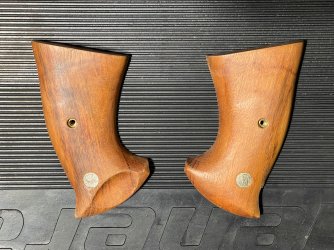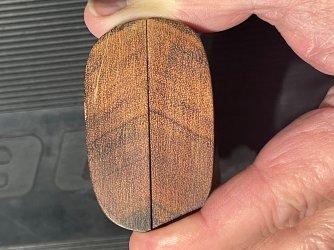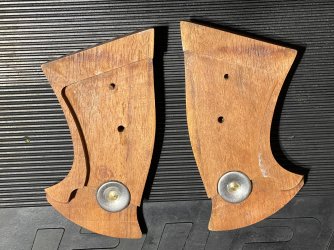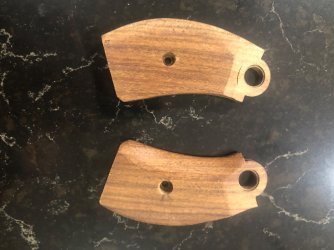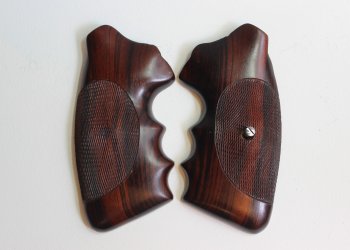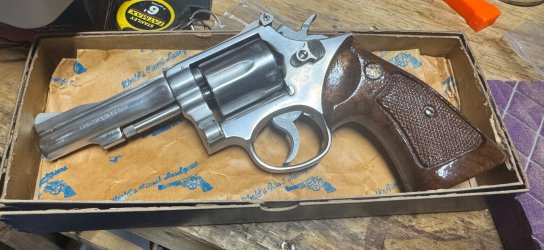Recent acquisition came with these presentation stocks. Not horrible but the left panel has some flaking of the finish. Not sure if this finish is even factory. Not a huge fan of the high gloss plastic appearance. Should I strip this off? If so, using what? What to refinish with? Leave them alone?
You are using an out of date browser. It may not display this or other websites correctly.
You should upgrade or use an alternative browser.
You should upgrade or use an alternative browser.
Stock Finish Problem
- Thread starter flundertaker
- Start date
Register to hide this ad
Soaked in acetone will remove everything and not damage the medallions.
A clear spray enamel will mock the original factory appearance
A clear spray enamel will mock the original factory appearance
The way the chips go down to the wood I would say it is original lacquer. I also would strip with acetone and spray with lacquer to mimic the original finish. Individual stocks vary greatly in finish application so you can spend as much time or not on getting a perfect finish. Make sure all the finish is off, a light sanding and buffing with a scotch-brite pad helps. If you use lacquer verses urethane, you can complete the spraying all in one day (actually one extended application period if you want) with multiple light applications and no need to sand in between. You can buff with scotch-brite pads after to get a smoother finish and or cut the sheen or increase the sheen with addition of paste wax.
Didn't S&W make the medallions out of plastic for a time?
I'm not familiar with the era and grip type(s) they were used on If there were specific ones, and it may not be the case here at all.
But if they are plastic it's a good chance soaking in acetone will make them into a blob of goo.
Acetone does that to many plastics.
Otherwise, if they are metal ones, acetone or even lacquer thinner soak will generally remove the stuff. Some people refinish them with shellac too. That's available as a spray finish now as well and can be applied evenly and quickly. It too can chip, can craze and even get soft if built up to much and then exposed to some heat.
Spray laq or poly work well for built up finish. Some of the poly is quick drying as well.
Use very thin coats.
I'm not familiar with the era and grip type(s) they were used on If there were specific ones, and it may not be the case here at all.
But if they are plastic it's a good chance soaking in acetone will make them into a blob of goo.
Acetone does that to many plastics.
Otherwise, if they are metal ones, acetone or even lacquer thinner soak will generally remove the stuff. Some people refinish them with shellac too. That's available as a spray finish now as well and can be applied evenly and quickly. It too can chip, can craze and even get soft if built up to much and then exposed to some heat.
Spray laq or poly work well for built up finish. Some of the poly is quick drying as well.
Use very thin coats.
Great advice 2152hq
Plastic medallions 1951-2 approx.
OP's grips are 70's
Plastic medallions 1951-2 approx.
OP's grips are 70's
Lacquer dries almost on contact if not overdone and each coat melts the previous forming the bond. Furniture is most often finished with lacquer because it is so easy and quick (with proper safety precautions) and I assume why S&W used it. Polyurethane needs sanding between coats for a mechanical bond and dries much slower but protects better and isn't apt to chip down to the wood. I haven't tried brushing lacquer but I hear it can be difficult so if brushing is the only option, I would use polyurethane.
Got them stripped with acetone. Very easy. Now trying to decide on what to refinish with. I want a low gloss almost matte finish I think. Just not a huge fan of the almost plastic like mirror gloss they had originally. I have tru oil on hand but I think that will give a high gloss finish. Suggestions on product for refinish?
Eta: not sure why each photo I attach gets flipped in the process. Annoying. Sorry.
Eta: not sure why each photo I attach gets flipped in the process. Annoying. Sorry.
Attachments
JSticks
Member
What I would try is sanding with finer paper until the wood is as smooth as possible, then rub hard with 0000 Steel Wool. The wood should feel "right" to you then swab it with regular boiled linseed oil, several times, letting it dry between coats. They will seal the finish. Here's some stocks I'm making for a 64-7 round butt. Just one coat of linseed oil on the interior curve to see what it would look like. Good thing is if don't like it's easy to return to "original" condition.Got them stripped with acetone. Very easy. Now trying to decide on what to refinish with. I want a low gloss almost matte finish I think. Just not a huge fan of the almost plastic like mirror gloss they had originally. I have tru oil on hand but I think that will give a high gloss finish. Suggestions on product for refinish?
Eta: not sure why each photo I attach gets flipped in the process. Annoying. Sorry.
Attachments
If you like a softer finish and not set on original, you might want to try burnishing and paste wax. It was a favorite of the SoCal grip makers and only finish used by Guy Hogue. I burnish with scotch-brite pads and apply Minwax Finishing Wax, wait 5-15 minutes and hit with a wheel buffer or hand buff. If you use a wheel buffer watch out it doesn't throw your grips. Here are some wax only examples.
Pau Ferro Guy Hogue

Goncalo Guy Hogue
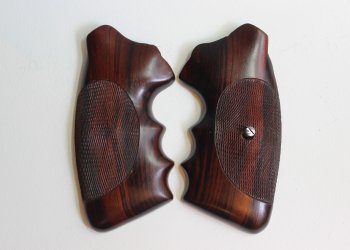
Mesquite John Hurst
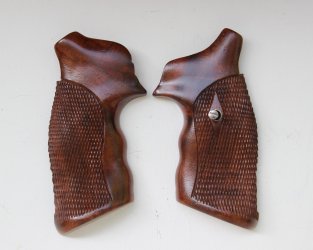
Pau Ferro Guy Hogue

Goncalo Guy Hogue

Mesquite John Hurst

Attachments
Tru oil. Easy to work with, cheap and you can get as glossy as you want
JSticks
Member
Sorry, I triggered a reply by mistake and don't know how to get rid of it without posting. I really have nothing more to say on the subject. So instead I'll post a picture of the 64-7 with my first attempt at stocks finished with BLO (boiled linseed oil) and wax.What I would try is sanding with finer paper until the wood is as smooth as possible, then rub hard with 0000 Steel Wool. The wood should feel "right" to you then swab it with regular boiled linseed oil, several times, letting it dry between coats. They will seal the finish. Here's some stocks I'm making for a 64-7 round butt. Just one coat of linseed oil on the interior curve to see what it would look like. Good thing is if don't like it's easy to return to "original" condition.
Attachments
DBrainard
Member
If you like a softer finish and not set on original, you might want to try burnishing and paste wax. <snip>
The wax-only finish is beautiful. How do you handle the checkered areas?
I do put some wax in/in the checkering with a toothbrush but I don't let it sit, just brush it out immediately with several clean toothbrushes. Depending how the checkering looks with the rest of the wood, I usually only apply wax to the checkering one or twice. You can control the sheen on the grips with the numbers of coats and whether you let the wax harden up before buffing. I haven't had any issues with the checkering while buffing on a wheel attached to my bench grinder. Easy to touch up or repair and I've removed wood off grips and simply apply a little wax and buff and you wouldn't know the difference. The wheel will grab the edge of the grips and send them flying if not held firmly and paying attention to direction and don't apply too much pressure. A good job can also be done by hand if you don't have a bench grinder/buffer or don't want to use it.The wax-only finish is beautiful. How do you handle the checkered areas?
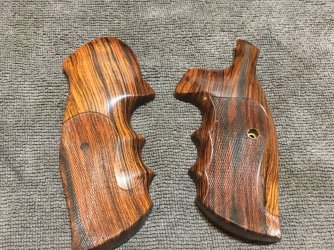
This is just personal preference but I like Tru-oil (back in my day it was a Birchwood Casey product - no idea about these days) - because I like a more natural wood look and don't like shiny finishes.Got them stripped with acetone. Very easy. Now trying to decide on what to refinish with. I want a low gloss almost matte finish I think. Just not a huge fan of the almost plastic like mirror gloss they had originally. I have tru oil on hand but I think that will give a high gloss finish. Suggestions on product for refinish?
Eta: not sure why each photo I attach gets flipped in the process. Annoying. Sorry.
Another choice would be satin lacquer.
Riposte
- Joined
- Sep 16, 2023
- Messages
- 765
- Reaction score
- 1,547
Where does one find good paste wax these days?
A question to VTGW938 in post 15 - controlling the sheen by number of coats of wax and letting it dry or not before buffing - which makes more shine - buffing wax off before it dries or after.
I'm assuming more coats and buffing dry wax produces a higher shine ?
I'm assuming more coats and buffing dry wax produces a higher shine ?
Last edited:
Yes, to get more shine let the wax dry a bit and than buff with buffing wheel or soft cloth and give them more coats. If starting from scratch you want to burnish the wood to get it smooth & hard.You can also buff your factory stocks to get a higher shine if you want.A question go VTGW938 in post 15 - controlling the sheen by number of coats of wax and letting it dry or not before buffing - which makes more shine - buffing wax off before it dries or after.
I'm assuming more coats and buffing dry wax produces a higher shine ?
Last edited:
Similar threads
- Replies
- 6
- Views
- 465
- Replies
- 1
- Views
- 654



